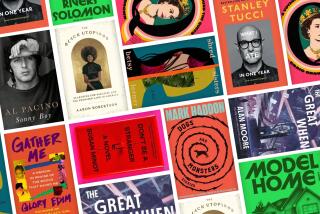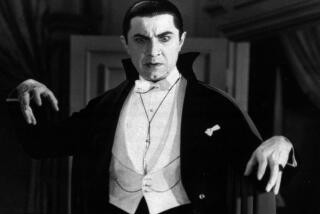Books that are delightfully strange, frightening and have parent issues
In three new works of fiction that push the boundaries of science-fiction and horror, parenting (and being parented) turn out to be critical and even life-threatening concerns — especially when it comes to distinguishing where one process ends and another begins.
Bethany C. Morrow
Unnamed Press: 192 pp., $24.99
The protagonist of Bethany Morrow’s “Mem” has an especially difficult time just keeping track of her numerous progenitors. First in line of parental responsibility is probably the Professor, head of an experimental underground laboratory where, for a price, wealthy people are relieved of their traumatic experiences which are then turned into pale, shadowy creatures. One of these creatures (not so pale or shadowy as the others) is the narrator, known around the Vault as Dolores Extract No. 1, but who refers to herself in her most secret thoughts as Elsie.
As Elsie develops, she turns out to be an unusual emanation that can go on to live her own life independent from her original Source. She leaves the Vault, explores the cultural opportunities of Montreal in the early 1900s and carries on conducting her complex speculations about who made her. Perhaps it was the actual parents of the young woman from whom she was extracted. Or perhaps it was the traumatic event which woke her to an independent existence — Dolores’s witnessing of Montreal’s first traffic fatality. And then there are all her friends who helped inspire and shape her and even her own experiences as an already-grown-up child living in the Vault, where she spent years observing what happened to the other Mems who weren’t as lucky as her, and who fulfill the prognoses that most Mems receive when they’re first created — they fade away and extinguish:
The first Walter Mems never lived longer than a year. They were little boys afraid of the daylight. When they left the corners of their dormitory, they scurried around the facility like beaten dogs, except that their heads stayed tucked between shoulders like little turtles. In their nervous condition, they sometimes ran into doors or the corners of walls despite having been trained safe routes to wander. And even though Walter never spared a thought to how they were faring or that they were in the Vault in the first place, it was for Mems such as Walter’s that the Professor brought nurses into the facility. Mems were personal possessions and, like the bank, the Vault strived to foster confidence that nothing but expiration would alter a Source’s belonging.
“Mem” is an unusual first novel set in an alternate past that brings a powerful vision to bear on the horrors (and opportunities) of trying to establish your own identity in a world that makes no space for you. Elsie’s world (like ours) is one where scientific advances don’t always make people happier, and where showing compassion to the objects of scientific research worries the humanity of those who produced them. (Ergo: If we give them nurses, we think of them as human; and if we think of them as human, why do we do these horrible things to them?) And while “Mem” takes a while to establish its chronology, especially during the opening chapters, Morrow drives her premise to a memorable conclusion about who shapes whom in the endless laboratory experiment of being alive.
*

“Night-Gaunts: and Other Tales of Suspense”
Joyce Carol Oates
The Mysterious Press: 320 pp., $26
At this point in Joyce Carol Oates’s almost absurdly productive literary career, there’s no sense trying to tally the number of novels and story collections she has published — not even over the last year. (Let’s just say it’s a lot.) But selecting the Oates books most worth reading requires a rule of thumb, and here’s mine: the longer an Oates book, the less successful it will probably be. Take, for example, the rather exasperating recent big novels, such as the Gothic historical nightmare, “The Accursed,” or the brutal family-romance murder mystery, “My Sister, My Love.” In these dense, elbow-wearying books, Oates often seems to wake up every few days or so, forgets her original premise, and takes off on another narrative riff altogether. It can feel a little bit like being drowned in words. (And drowning, incidentally, is one of the recurring fates of many Oates characters.)
But in Oates’s shorter fictions, she excels, especially in her volumes of “macabre” or “suspense” stories, such as the latest, “Night-Gaunts.” In the title story, she tells about an isolated, Lovecraftian child growing up in a decayed Providence mansion while trying to meet the mad expectations of his overwrought father. When his father is committed to an asylum (and eventually dies), this means living also with the delusions he left behind, and Horace Phineas Love Jr., (HPL — get it?) soon finds his life haunted by pale spectral creatures who “might be discovered in a mildly shadowed corner of the child’s room, or reflected behind the child in a mirror; on the narrow, steep stairs leading to the third floor of the house: a shimmering figure transparent as a jellyfish…” Like Oates’s best macabre stories, this one doesn’t let go until it’s finished with you.
There are other good stories here, such as “The Long-Legged Girl” or “The Woman in the Window,” both of which develop from Oates’s recurring narrative obsessions about older men seeking to dominate younger women and the younger woman who let them (until, often quite violently, they stop). But there are also some over-long, broken-backed stories in here too. If you’re interested in Oates’s dark, generally humorless and almost-always-absorbing stories of the “grotesque,” try one of her earlier collections first, such as “The Collector of Hearts” or “Haunted.”
*
Marika Ōhara
University of Minnesota Press: 304 pp., $19.95 paper
I can still remember back when the term “speculative” fiction was considered the kiss of death by commercial publishers; but in recent years, it has come proudly out of the closet. It usually denotes fiction that takes a strange or surreal premise (such as repressed Mems living in a scientific research facility) and drives it to some logical narrative conclusion, refusing to lapse into surreal or meretricious gags and juxtapositions. (The best-known writers of “speculative” fiction include Kelly Link and Karen Joy Fowler.) But like most generic terms, this one is bendable — especially in a novel like “Hybrid Child,” which is (according to its publicity) the first English translation of a “major work of science fiction by a female Japanese author” but feels more like a big splashy outrageous fairy-tale with a few techno-terms tossed around for texture. It’s a weird, funny, frustrating “fix-up” of a book, with a self-contained opening story that suddenly sling-shots off (à la Van Vogt) into an escalatingly wild interstellar adventure, but that opening story alone is worth the price of admission. The main protagonist (like Morrow’s Elsie) is an experiment that has outgrown its laboratory: Sample B #3 has been created with the ability to adapt its structure to mimic anything it eats. And so it eats: a lonely mother bereft of her child, her child who has been converted into a sort of cybernetic Alexa in the basement, and a spaceship. Then it takes off for parts unknown.
“Hybrid Child” reminds me of the equally unpredictable stuff published as science fiction back in the “Golden Age” but which didn’t seem to have anything “scientific” about it except a willingness to go anywhere. And reading Ōhara’s novel it’s clear that one thing hasn’t changed at all — if fiction works, we don’t care what they call it. SF? Spec fic? Macabre? Grotesque? Might as well ask if it was Mom and Dad who made you, or if you made yourself.
At the end of the day, we’re all mostly the same stuff.
Bradfield is the author of a dozen books including, most recently, the novel “Dazzle Resplendent: Adventures of a Misanthropic Dog.”
More to Read
Sign up for our Book Club newsletter
Get the latest news, events and more from the Los Angeles Times Book Club, and help us get L.A. reading and talking.
You may occasionally receive promotional content from the Los Angeles Times.







